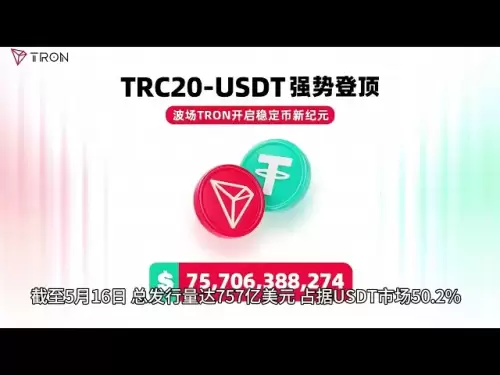 |
|
 |
|
 |
|
 |
|
 |
|
 |
|
 |
|
 |
|
 |
|
 |
|
 |
|
 |
|
 |
|
 |
|
 |
|
Cryptocurrency News Articles
The cryptocurrency market is seeing yet another bullish momentum, and investors are pouring funds into stablecoins before buying volatile assets.
May 22, 2025 at 04:05 pm
According to data from CoinMarketCap, the total value of stablecoins is close to an all-time high of $250 billion, thanks to the steady rise

The cryptocurrency market is seeing yet another bullish momentum, and investors are pouring funds into stablecoins before buying volatile assets.
According to data from CoinMarketCap, the total value of stablecoins is close to an all-time high of $250 billion, thanks to the steady rise since January.
Tether’s USDT is leading the pack with a $152.4 billion market cap. Circle’s USDC is at $61 billion.
The increasing demand for stablecoins came as Bitcoin reached a new ATH of nearly $112,000 earlier today. Moreover, the global crypto market cap is at a local high of $3.52 trillion — $200 billion away from its ATH in mid-December 2024.
Can the GENIUS Act Bring Trillions?
David Sacks, the White House crypto and AI czar, says yes.
Sacks is optimistic that the GENIUS Act (Giving Equitable National Interest to US Stablecoins) will increase the demand for US Treasuries, according to a CNBC report.
This is because the bill would create a clear regulatory framework for stablecoins, which would make them more appealing to institutional investors.
Higher demand for Treasuries makes it easier for the US government to borrow money, resulting in low interest rates. This would push investors toward diverse investments like stocks and cryptocurrencies.
So far, 15 democrats have joined the republicans in supporting the GENIUS Act.
On May 20, Coinspeaker reported that some of the Democratic Senators — Mark Warner, Adam Schiff, and Ruben Gallego, to name a few — shifted from opposing the bill to supporting it.
The GENIUS Act will bring a clear regulatory framework for stablecoins. For instance, it will only allow regulated fintech companies and banks to issue stablecoins.
It’s not just the US that’s trying to profit from stablecoins. On May 21, Hong Kong’s Legislative Council passed a bill that allows institutions to apply for stablecoin issuance licenses through the Hong Kong Monetary Authority to boost the region’s crypto growth.
On May 20, Lee Jae-myung, a South Korean democratic presidential candidate, proposed the creation of a won-backed stablecoin.
Wahid has been analyzing and reporting on the latest trends in the decentralized ecosystem since 2019. He has over 4,000 articles to his name and his work has been featured on some of the leading outlets including Yahoo Finance, Investing.com, Cointelegraph, and Benzinga. Other than reporting, Wahid likes to connect the dots between DeFi and macro on his newsletter, On-chain Monk.
Wahid Pessarlay on Xoutput:
An interesting angle to consider is that if the GENIUS Act leads to a substantial increase in demand for US Treasuries, it could have a broader impact on the financial markets. With increased demand, the prices of Treasuries would rise, and the yields would fall. This scenario could create an environment where investors would be enticed to invest in riskier assets, such as stocks and cryptocurrencies.
In essence, the GENIUS Act could set in motion a chain reaction that would ultimately benefit the broader economy. It could foster new technologies, generate jobs, and promote inclusive growth. However, it's important to note that this analysis is based on the assumption that the Act will be passed and that it will have the desired effect on the financial markets.
In the crypto sphere, anything can happen, and it will be fascinating to observe how this story unfolds in the coming months.
Key Notes:
* The total value of stablecoins is now close to $250 billion, while the global crypto market cap is at a local high of $3.52 trillion.
* The GENIUS Act could increase demand for US Treasuries, making it easier for the government to borrow money at low interest rates.
* So far, 15 democrats have joined the republicans in supporting the GENIUS Act.
* The bill would only allow regulated fintech companies and banks to issue stablecoins, and it would provide clear rules for the use of stablecoins.
* The Hong Kong Monetary Authority will grant stablecoin issuance licenses to institutions to boost the region’s crypto growth.
* Lee Jae-myung, a South Korean democratic presidential candidate, has proposed the creation of a won-backed stablecoin.
The post Stablecoins Hit All-Time High As Investors Flee Volatile Assets For Safe Haven Coins appeared first on Benzinga.
Disclaimer:info@kdj.com
The information provided is not trading advice. kdj.com does not assume any responsibility for any investments made based on the information provided in this article. Cryptocurrencies are highly volatile and it is highly recommended that you invest with caution after thorough research!
If you believe that the content used on this website infringes your copyright, please contact us immediately (info@kdj.com) and we will delete it promptly.
-

-

-

-

-

-

-

-

- AVAX native token of Avalanche blockchain is gaining momentum, buoyed by fresh institutional activity and a major partnership with FIFA
- May 22, 2025 at 11:25 pm
- Avalanche's native token, AVAX, is gaining momentum in the current crypto market surge, buoyed by fresh institutional activity and a major partnership with FIFA.
-

- PENDLE is currently trading at $4.32 and has decreased by 2.34% in the last 24 hours.
- May 22, 2025 at 11:20 pm
- PENDLE is currently trading at $4.32 and has decreased by 2.34% in the last 24 hours. The cryptocurrency has had a 3.53% rise over the week so far, showing some strength in the price trend.


























































